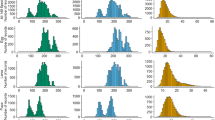Abstract
The life cycle and abundance of the tansy ragwort flea beetle,Longitarsus jacobaeae (Waterhouse), were investigated in a dune area in the Netherlands. The beetle overwinters in the egg stage, which is parasitised by a Mymarid wasp. No larvae were found until spring. Three larval instars can be separated by head capsule size and coloration. Initial larval numbers are high (up to 214 larvae per plant), but drop to very low levels by late spring. Adults appear during June or July, the numbers are high until October, the adults can be found until the end of December. This life cycle differs remarkably from those described for the species in Switzerland, Italy and Britain. Possible causes for these differences are discussed, as well as implications for the use ofLongitarsus in biological control.
Résumé
Le cycle biologique et l'abondance de la chrysomèleLongitarsus jacobaeae (Waterhouse) ont été étudiés dans les dunes littorales de Hollande. L'espèce hiverne à l'état d'œuf. Les œufs peuvent être parasités par un hyménoptère Mymaridae. On ne peut pas trouver de larves avant le printemps. Il y a 3 stades larvaires qu'on peut distinguer par la mesure et la couleur de leur capsule céphalique. Au début, il y a beaucoup de larves par plante infestée (jusqu'à 214); en fin de printemps leur nombre est fortement réduit. Les adults apparaissent en Juin et Juillet et ils sont communs jusqu'en Octobre. Mais on peut les trouver normalement jusqu'à la fin de Décembre. Ce cycle est nettement différent de celui décrit pour l'espèce en Suisse, en Italie et en Grande Bretagne. Ces différences et les conséquences pour la lutte biologique contre le Séneçon avecLongitarsus sont discutées.
Similar content being viewed by others
References
Cullen, J. M. & Moore, A. D. — 1981. Preliminary observations onLongitarsus jacobaeae introduced for the biological control of ragwort in Australia. In:Proc. V th Int. Symp. Biol. Control Weeds (E. S. Delfosse, ed.). — Brisbane, Australia, 499–505.
Debauche, H. R. — 1948. Etude sur les Mymarromidae et les Mymaridae de la Belgique [Hymenoptera, Chalcidoidae]. —Mem. Mus. Hist. Nat. Belg., 1988, 1–248.
Dempster, J. P. — 1971. The population ecology of the Cinnabar MothTyria jacobaeae L. [Lepidoptera, Arctiidae]. —Oecologia (Berl.), 7, 26–67.
Frick, K. E. — 1970.Longitarsus jacobaeae [Coleoptera, Chrysomelidae] a flea beetle for the biological control of tansy ragwort. I. Host specificity studies. —Ann. Entomol. Soc. Am., 63, 284–296.
Frick, K. E. — 1971.Longitarsus jacobaea [Coleoptera, Chrysomelidae] a flea beetle for the biological control of tansy ragwort. II. Life history of a Swiss biotype. —Ann. Entomol. Soc. Am., 64, 834–840.
Firck, K. E. &Johnson, G. R. — 1972.Longitarsus jacobaeae [Coleoptera, Chrysomelidae] a flea beetle for the biological control of tansy ragwort. 3. Comparison of the biologies of the egg stage of Swiss and Italian biotypes. —Ann. Entomol. Soc. Am., 65, 406–410.
Frick, K. E. &Johnson, G. R. — 1973.Longitarsus jacobaeae [Coleoptera, Chrysomelidae] a flea beetle for the biological control of tansy ragwort. 4. Life history and adult aestivation of an Italian biotype. —Ann. Entomol. Soc. Am., 66, 358–367.
Harris, P., Wilkinson, A. T. S. & Myers, J. H. — 1984.Senecio jacobaea Tansy Ragwort [Compositae]. In: Biological control programmes against insects and weeds in Canada 1969–1980. (J. S. Kelleher, & M. A. Hulme, eds.). —Commonw. Agric. Bur., 195–201.
Hawkes, R. B. &Johnson, G. R. — 1978.Longitarsus jacobaeae aids moth in the biological control of tansy ragwort. — In:Proc. IV th Int. Symp. Biol. Contr. Weeds (T. E. Freeman, ed.). —University of Gainesvilles, Florida, 193–196.
Julien, M. H. — 1987. Biological Control of weeds. A world catalogue of agents and their target weeds. —CAB Int., Oxon UK.
McEvoy, P. B. — 1985. Depression in ragwort [Senecio jacobaea] abundance following introduction ofTyria jacobaeae andLongitarsus jacobaeae on the central coast of Oregon. In:Proc. VI th Int. Symp. Biol. Contr. Weeds. (E. S. Delfosse, ed.). —Agriculture Canada, Vancouver Canada, 57–64.
Meijden, E. van der — 1979. Herbivore exploitation of a fugitive plant species: Local survival and extinction of cinnabar moth and ragwort in a heterogeneous environment. —Oecologia (Berl.), 42, 307–323.
Newton, H. C. F. — 1933. On the biology of some species ofLongitarsus living on ragwort. —Bull. Entomol. Res., 24, 511–520.
Piper, G. L. — 1985. Biological control of weeds in Washington: status report. In:Proc. VI th Int. Symp. Biol. Contr. Weeds. (E. S. Delfosse, ed.). —Agriculture Canada, Vancouver Canada, 57–64.
Shute, M. — 1975.Longitarsus jacobaea Waterhouse [Coleoptera: Chrysomelidae]: identity and distribution. —Entomol. Mon. Mag., 111, 33–39.
Syrret, P. — 1985. Host specificity of the ragwort flea beetleLongitarsus jacobaeae (Waterhouse) [Coleoptera: Chrysomelidae]. —New Zealand J. Zool., 12, 335–340.
Waloff, N. &Jervis, M. A. — 1987. Communities of parasitoids associated with leafhoppers and planthoppers in Europe. —Adv. Ecol. Res., 17, 281–377.
Author information
Authors and Affiliations
Rights and permissions
About this article
Cite this article
Windig, J.J. Life cycle and abundance oflongitarsus jacobaeae [Col.: Chrysomelidae], biocontrol agent ofSenecio jacobaea . Entomophaga 36, 605–618 (1991). https://doi.org/10.1007/BF02374443
Received:
Accepted:
Issue Date:
DOI: https://doi.org/10.1007/BF02374443




